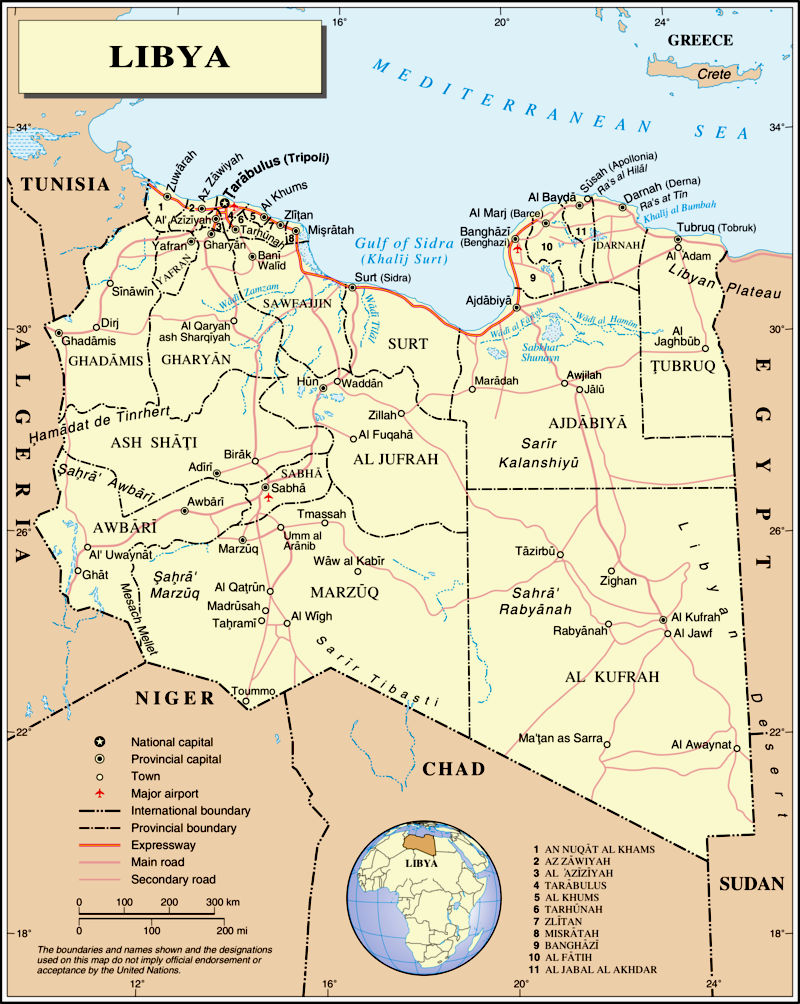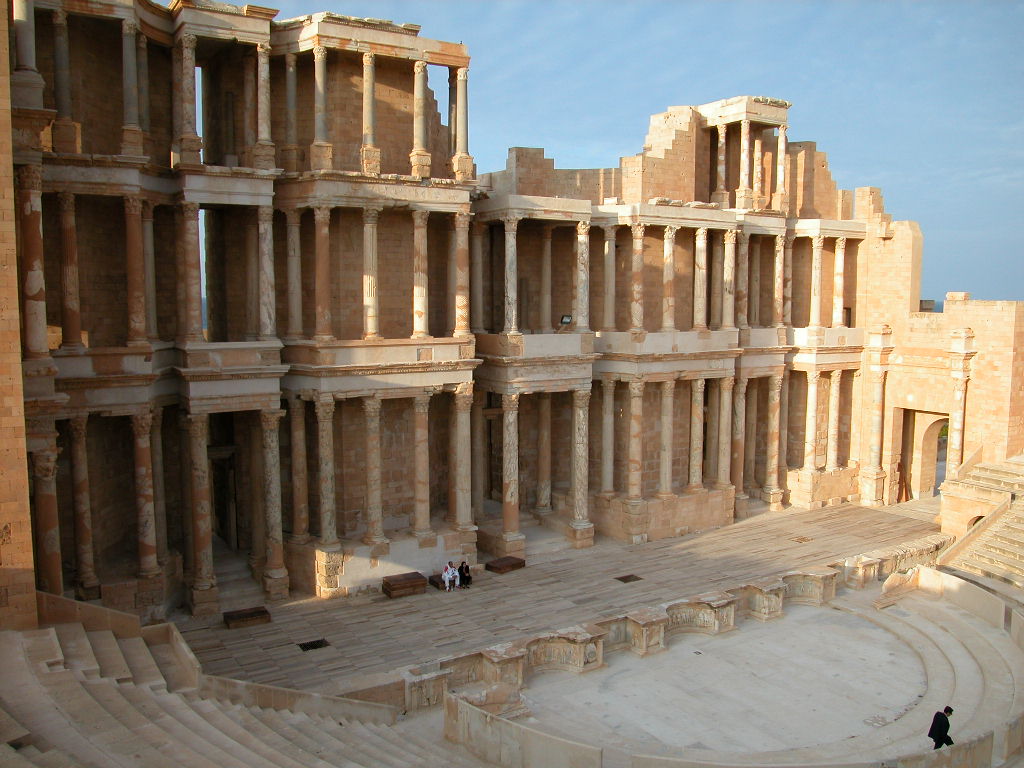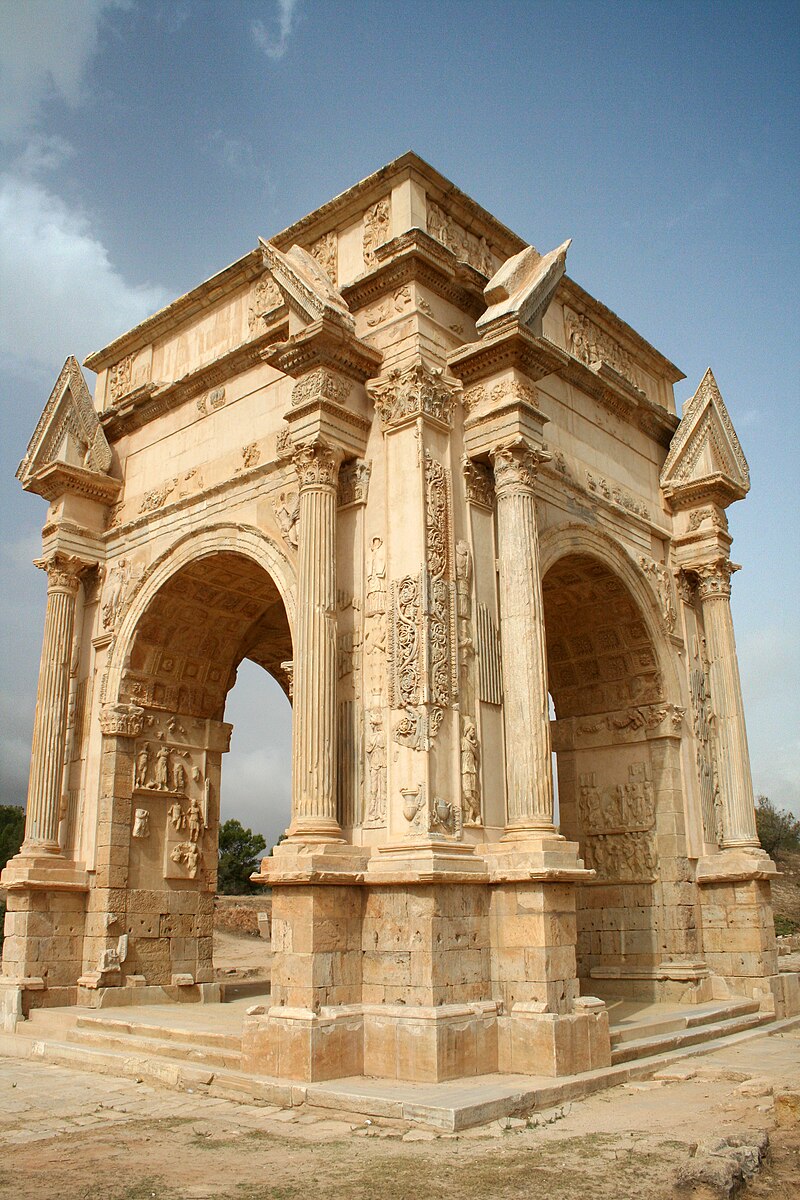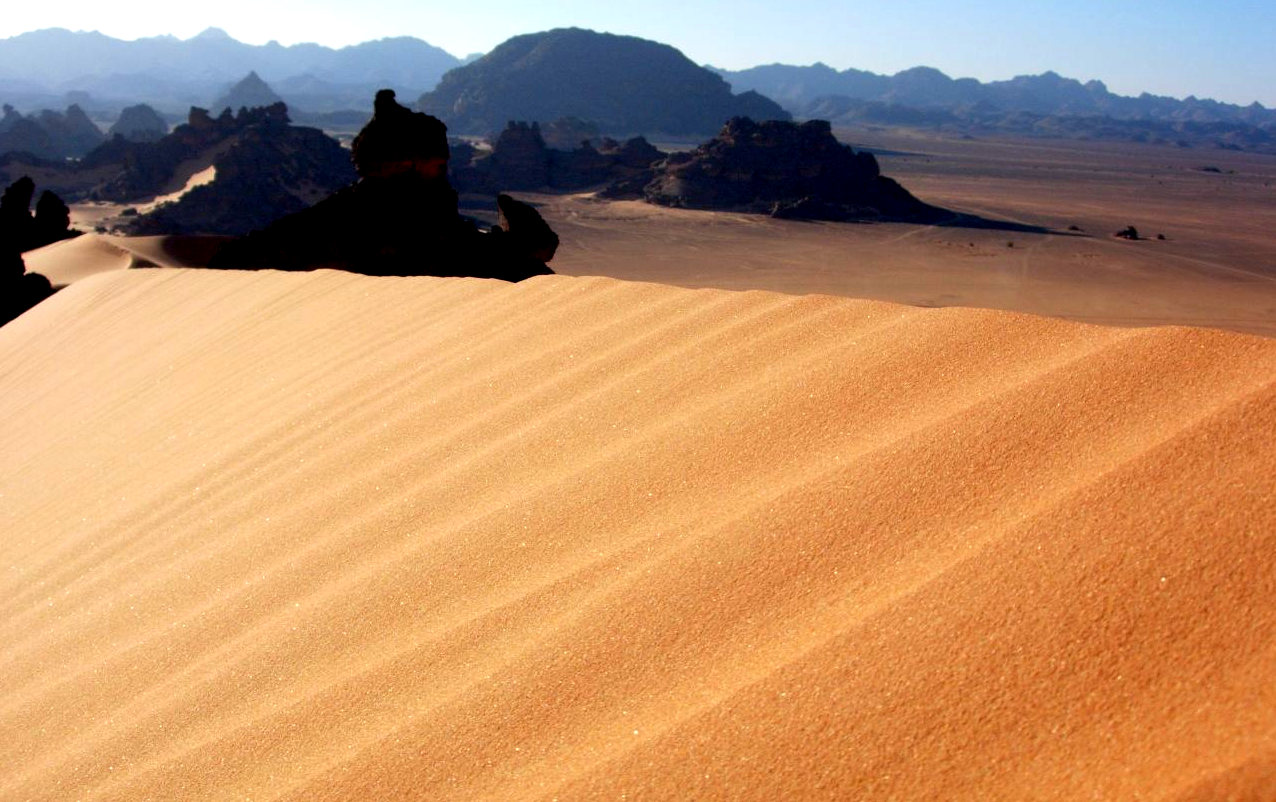
Libya, officially the State of Libya, is a country in the Maghreb region of North Africa. Libya borders the
Mediterranean Sea to the north,
Egypt to the east, Sudan to the southeast, Chad to the south, Niger to the southwest, Algeria to the west, and Tunisia to the northwest. Libya comprises three historical regions: Tripolitania, Fezzan, and Cyrenaica. With an area of almost 1.8 million km2 (700,000 sq mi), it is the fourth-largest country in Africa and the Arab world, and the 16th-largest in the world. Libya claims 32,000 square kilometers of southeastern Algeria, south of the Libyan town of Ghat. The country's official religion is Islam, with 96.6% of the Libyan population being Sunni Muslims. The official language of Libya is Arabic, with vernacular Libyan
Arabic being spoken most widely. The majority of Libya's population is Arab. The largest city and capital, Tripoli, is located in northwestern Libya and contains over a million of Libya's seven million people.
Libya has been inhabited by Berbers since the late Bronze Age as descendants from Iberomaurusian and Capsian cultures. In classical antiquity, the Phoenicians established city-states and trading posts in western Libya, while several Greek cities were established in the East. Parts of Libya were variously ruled by Carthaginians, Persians, and
Greeks before the entire region becoming a part of the
Roman Empire. Libya was an early center of
Christianity. After the fall of the Western
Roman
Empire, the area of Libya was mostly occupied by the Vandals until the 7th century when invasions brought Islam to the region. From then on, centuries of Arab migration to the Maghreb shifted the demographic scope of Libya in favor of Arabs. In the 16th century, the Spanish Empire and the Knights of St John occupied Tripoli until Ottoman rule began in 1551. Libya was involved in the Barbary Wars of the 18th and 19th centuries. Ottoman rule continued until the Italo-Turkish War, which resulted in the Italian occupation of Libya and the establishment of two colonies, Italian Tripolitania and Italian Cyrenaica (1911–1934), later unified in the Italian Libya colony from 1934 to 1943.
During the Second World
War, Libya was an area of warfare in the North African Campaign. The Italian population then went into decline. Libya became independent as a kingdom in 1951. A bloodless military coup in 1969, initiated by a coalition led by Colonel Muammar Gaddafi, overthrew King Idris I and created a republic. Gaddafi was often described by critics as a dictator, and was one of the world's longest serving non-royal leaders, ruling for 42 years. He ruled until being overthrown and killed during the 2011 Libyan Civil War, which was part of the wider Arab Spring, with authority transferred to the National Transitional Council then to the elected General National Congress. By 2014 two rival authorities claimed to govern Libya, which led to a second civil war, with parts of Libya split between the Tobruk and Tripoli-based governments as well as various tribal and Islamist militias. The two main warring sides signed a permanent ceasefire in 2020, and a unity government took authority to plan for democratic elections, though political rivalries continue to delay this. Libya is a developing country ranking 104th by HDI and has the 10th-largest proven oil reserves in the world. Libya is a member of the
United
Nations, the Non-Aligned Movement, the African Union, the Arab League, the OIC and
OPEC.

ANCIENT LIBYA
The coastal plain of Libya was inhabited by Neolithic peoples from as early as 8000 BC. The Afroasiatic ancestors of the Berber people are assumed to have spread into the area by the Late Bronze Age. The earliest known name of such a tribe was the Garamantes, based in Germa. The Phoenicians were the first to establish trading posts in Libya. By the 5th century BC, the greatest of the Phoenician colonies, Carthage, had extended its hegemony across much of North Africa, where a distinctive civilization, known as Punic, came into being.
In 630 BC, the ancient Greeks colonized the area around Barca in Eastern Libya and founded the city of Cyrene. Within 200 years, four more important Greek cities were established in the area that became known as Cyrenaica. The area was home to the renowned philosophy school of the Cyrenaics. In 525 BC the Persian army of Cambyses II overran Cyrenaica, which for the next two centuries remained under Persian or Egyptian rule. Alexander the Great ended Persian rule in 331 BC and received tribute from Cyrenaica. Eastern Libya again fell under the control of the Greeks, this time as part of the
Ptolemaic
Kingdom.
After the fall of Carthage the Romans did not immediately occupy Tripolitania (the region around Tripoli), but left it instead under control of the kings of Numidia, until the coastal cities asked and obtained its protection. Ptolemy Apion, the last Greek ruler, bequeathed Cyrenaica to
Rome, which formally annexed the region in 74 BC and joined it to Crete as a Roman province. As part of the Africa Nova province, Tripolitania was prosperous, and reached a golden age in the 2nd and 3rd centuries, when the city of Leptis Magna, home to the Severan dynasty, was at its height.
On the Eastern side, Cyrenaica's first Christian communities were established by the time of the Emperor Claudius. It was heavily devastated during the Kitos War and almost depopulated of Greeks and Jews alike. Although repopulated by Trajan with military colonies, from then started its decline. Libya was early to convert to Nicene Christianity and was the home of Pope Victor I; however, Libya was also home to many non-Nicene varieties of early Christianity, such as Arianism and Donatism.

GEOGRAPHY
Libya extends over 1,759,540 square kilometres (679,362 sq mi), making it the 16th largest nation in the world by size. Libya is bound to the north by the
Mediterranean
Sea, the west by Tunisia and Algeria, the southwest by Niger, the south by Chad, the southeast by Sudan, and the east by Egypt. Libya lies between latitudes 19° and 34°N, and longitudes 9° and 26°E.
At 1,770 kilometres (1,100 mi), Libya's coastline is the longest of any African country bordering the Mediterranean. The portion of the Mediterranean Sea north of Libya is often called the Libyan Sea. The climate is mostly extremely dry and desertlike in nature. However, the northern regions enjoy a milder Mediterranean climate.
Six ecoregions lie within Libya's borders: Saharan halophytics, Mediterranean dry woodlands and steppe, Mediterranean woodlands and forests, North Saharan steppe and woodlands, Tibesti-Jebel Uweinat montane xeric
woodlands, and West Saharan montane xeric woodlands.
Natural hazards come in the form of hot, dry, dust-laden sirocco (known in Libya as the gibli). This is a southern wind blowing from one to four days in spring and autumn. There are also dust storms and sandstorms. Oases can also be found scattered throughout Libya, the most important of which are Ghadames and Kufra. Libya is one of the sunniest and driest countries in the world due to prevailing presence of desert environment.
Libya was a pioneer state in North Africa in species protection, with the creation in 1975 of the El Kouf protected area. The fall of Muammar Gaddafi's regime favoured intense poaching: "Before the fall of Gaddafi even hunting rifles were forbidden. But since 2011, poaching has been carried out with weapons of war and sophisticated vehicles in which one can find up to 200
gazelle heads killed by militiamen who hunt to pass the time. We are also witnessing the emergence of hunters with no connection to the tribes that traditionally practice hunting. They shoot everything they find, even during the breeding season. More than 500,000
birds are killed in this way each year, when protected areas have been seized by tribal chiefs who have appropriated them. The animals that used to live there have all disappeared, hunted when they are edible or released when they are not," explains zoologist Khaled Ettaieb.
LIBYAN DESERT
The Libyan Desert, which covers most of Libya, is one of the most arid and sun-baked places on earth. In places, decades may pass without seeing any rainfall at all, and even in the highlands rainfall seldom happens, once every 5–10 years. At Uweinat, as of 2006 the last recorded rainfall was in September 1998.
Likewise, the temperature in the Libyan Desert can be extreme; on 13 September 1922, the town of 'Aziziya, which is located southwest of Tripoli, recorded an
air temperature of 58 °C (136.4 °F), considered to be a world record. In September 2012, however, the world record figure of 58 °C was determined to be invalid by the World Meteorological Organization.
Slightly further to the south are the massifs of Arkenu, Uweinat, and Kissu. These granite mountains are ancient, having formed long before the sandstones surrounding them. Arkenu and Western Uweinat are ring complexes very similar to those in the Aïr Mountains. Eastern Uweinat (the highest point in the Libyan Desert) is a raised sandstone plateau adjacent to the granite part further west.
The plain to the north of Uweinat is dotted with eroded volcanic features. With the discovery of oil in the 1950s also came the discovery of a massive aquifer underneath much of Libya. The
water in the Nubian Sandstone Aquifer System pre-dates the last Ice ages and the Sahara Desert itself. This area also contains the Arkenu structures, which were once thought to be two impact craters.

OIL ECONOMY
The Libyan economy depends primarily upon revenues from the oil sector, which account for over half of GDP and 97% of exports. Libya holds the largest proven oil reserves in Africa and is an important contributor to the global supply of light, sweet crude. During 2010, when
oil averaged at $80 a barrel, oil production accounted for 54% of GDP. Apart from
petroleum, the other natural resources are natural gas and gypsum. The International Monetary Fund estimated Libya's real GDP growth at 122% in 2012 and 16.7% in 2013, after a 60% plunge in 2011.
The World Bank defines Libya as an 'Upper Middle Income Economy', along with only seven other African countries. Substantial revenues from the energy sector, coupled with a small population, give Libya one of the highest per capita GDPs in Africa. This allowed the Libyan Arab Jamahiriya state to provide an extensive level of social security, particularly in the fields of housing and education.
Libya faces many structural problems including a lack of
institutions, weak governance, and chronic structural unemployment. The economy displays a lack of economic diversification and significant reliance on immigrant labour. Libya has traditionally relied on unsustainably high levels of public sector hiring to create employment. In the mid-2000s, the government employed about 70% of all national employees.
Unemployment rose from 8% in 2008 to 21% in 2009, according to the census figures. According to an Arab League report, based on data from 2010, unemployment for women stands at 18% while for the figure for men is 21%, making Libya the only Arab country where there are more unemployed men than women. Libya has high levels of social inequality, high rates of youth unemployment and regional economic disparities.
Water supply is also a problem, with some 28% of the population not having access to safe drinking water in 2000.
Libya imports up to 90% of its cereal consumption requirements, and imports of wheat in 2012/13 was estimated at 1 million tonnes. The 2012 wheat production was estimated at 200,000 tonnes. The government hopes to increase food production to 800,000 tonnes of cereals by 2020. However, natural and environmental conditions limit Libya's agricultural production potential. Before 1958,
agriculture was the country's main source of revenue, making up about 30% of GDP. With the discovery of
oil in 1958, the size of the agriculture sector declined rapidly, comprising less than 5% GDP by 2005.
The country joined OPEC in 1962. Libya is not a WTO member, but negotiations for its accession started in 2004. In the early 1980s, Libya was one of the wealthiest countries in the world; its GDP per capita was higher than some developed countries.
In the early 2000s officials of the Jamahiriya era carried out economic reforms to reintegrate Libya into the global economy. UN sanctions were lifted in September 2003, and Libya announced in December 2003 that it would abandon programs to build weapons of mass
destruction. Other steps have included applying for membership of the
World Trade
Organization, reducing subsidies, and announcing plans for privatization.
Authorities privatized more than 100 government owned companies after 2003 in industries including oil refining, tourism and real estate, of which 29 were 100% foreign owned. Many international oil companies returned to the country, including oil giants
Shell and
ExxonMobil. After sanctions were lifted there was a gradual increase of air traffic, and by 2005 there were 1.5 million yearly air travellers. Libya had long been a notoriously difficult country for Western tourists to visit due to stringent visa requirements.
In 2007 Saif al-Islam Gaddafi, the second-eldest son of Muammar Gaddafi, was involved in a green development project called the Green Mountain Sustainable Development Area, which sought to bring tourism to Cyrene and to preserve Greek ruins in the area. On August 2011 it was estimated that it would take at least 10 years to rebuild Libya's infrastructure. Even before the 2011 war, Libya's infrastructure was in a poor state due to "utter neglect" by Gaddafi's administration, according to the NTC. By October 2012, the economy had recovered from the 2011 conflict, with oil production returning to near normal levels.
Oil production was more than 1.6 million barrels per day before the war. By October 2012, the average oil production has surpassed 1.4 million bpd. The resumption of production was made possible due to the quick return of major Western companies, like TotalEnergies, Eni, Repsol, Wintershall and Occidental. In 2016, an announcement from the company said the company aims 900,000 barrel per day in the next year. Oil production has fallen from 1.6 million barrel per day to 900,000 in four years of war.
The Great Man-Made River is the world's largest irrigation project. The project utilizes a pipeline system that pumps fossil water from the Nubian Sandstone Aquifer System from down south in Libya to cities in the populous Libyan northern Mediterranean coast including Tripoli and Benghazi. The water provides 70% of all freshwater used in Libya. During the second Libyan civil war, lasting from 2014 to 2020, the water infrastructure suffered neglect and occasional breakdowns. By 2017, 60% of the Libyan population were malnourished. Since then, 1.3 million people are waiting for emergency humanitarian aid, out of a total population of 7.1 million.
In March 2024, Libya is actively promoting business development and encouraging both domestic and foreign investment. This strategic initiative is aimed at securing long-term economic stability and prosperity for Libya by diversifying its economic foundation, decreasing reliance on a singular sector, and establishing resilience in the face of fluctuating oil markets. Embracing green industries like renewable energy, energy efficiency, sustainable agriculture, and eco-tourism holds the potential to generate fresh employment prospects across a spectrum of sectors, thereby addressing unemployment challenges, particularly among the youth demographic.
Oil revenues have made the country lazy. As oil declines in currency values, their vast deserts may provide alternative income from the generation of
renewable
electricity
using solar farms, and conversion to
hydrogen. Replacing a
fossil fuel economy with a
hydrogen based
grid. Using their oil to fund the transition to a
sustainable
energy future.

Solar
Cola 500ml
PET bottle
LINKS
and REFERENCE

DOOMSDAY
OPERATION GRAND SLAM -
Disillusioned extremists in Iran,
North Korea and Russia,
have grown impatient waiting for their leaders to act decisively, having
watched the Ukraine debacle
of Vladimir Putin rebound to weaken
their CRINK
axis members. This despite Hamas launching against Israel and
Houthi attacks on the Red
Sea. All that had the effect of waking the sleeping giant: NATO.
They
hatch a plot to kidnap top politicians from the west to create confusion,
as a prelude to an all out cyber
nuclear first and second strike, having first stockpiled sufficient gold
and weapons reserves, and fallout bunkers for their cells, to be able to
stage a second wave of conventional attacks, to in effect, take over the
world after the nuclear holocaust they
have engineered. Including assassinating their jaded leaders: Xi
Jinping; Vladimir
Putin, Iranian Grand Ayatollah, Ali
Khamenei, and Kim
Jong Un, supreme leader of communist North
Korea.
|
Adelaide
Aden
- Yemen
Afghanistan
Africa
Alaska
Albania
Algeria
Amazon
Rainforest
Amsterdam
Antarctic
Arctic
North Pole
Argentina
Asia
Athens
Atlantis
- Plato's Lost City
Australia
Austria
Aztecs
- Mexico
Baghdad
Bahamas
Bahrain
Bangladesh
Barbados
Beachy
Head, England
Belgium
Benin
Berlin
Bermuda
Black
Rock Desert
Bohemia
Bolivia Bonneville
Utah History
Bonneville,
Utah, USA
Brazil
Brighton
- West Pier
British
Columbia
Buckingham
Palace
Bulgaria
Burkina
Faso
Burma
California
Canada
Canary
Islands
Cape
Horn
Cape
Verde
Cape
York - Au
Caribbean
Cayman
Islands
Central
Africa
Chichester
Harbour
Chile
China
Columbo
- Sri Lanka
Columbia
Corfu
Cowes,
Isle of Wight
Croatia
Crooked
Island, Bahamas
Cuba
Cyprus
Czechoslovakia
Darwin
- Australia
Daytona
Beach
Denmark
Eastbounre
Pier, England
Earthquakes
Ecuador
Egypt
Eindhoven Estonia
Equator
Europe
Falkland
Islands
Falmouth,
Cornwall
Fiji
Finland
France
Galapagos
Islands
Geography
Links
Geography
Mountains
Geography
Records
Geography
Resources
Geography
Statistics
|
Germany
Ghana
Gibraltar
- Links
Greece
Greenland
Guinea
Guinea
Bissau
Hawaii
Holland
the Nertherlands
Hollywood,
California, LA
Hong
Kong
Hungary
Hurricanes
Iceland
India
Indonesia
Links
Iran
Iraq
Ireland
Isle
of Man
Isle
of Wight
- The
Needles
Israel
Italy
Ivory
Coast
Jakarta
- Java
Japan
Johannesburg
Jordan
Kent,
England
Kenya
Korea
Kuwait
Kyoto
Lanzarote,
Gran Canaria
Las
Vegas
Lebanon
Liberia
Libya
Liechtenstein
Life
on Earth
Lithuania
London
- Big
Ben
London
Eye
London
Houses
Parliament
London
- Buckingham
Palace
London
- Old
Bailey
London
- Overview
London
- The City
London
- Tower Bridge
London
- Trafalgar
Square
Luxembourg
Madame
Tussauds
Malaysia
Mali
Malta
Marshal
Islands
Mauritania
Maya
Empire -
Central America
Melbourne,
Australia
Middle
East
Melbourne,
Australia
Mexico
Monaco
Morocco
Mountains
Mumbai
Naples-
Italy
National
Geographic
Nepal
New
York
New
Zealand
Niger
Nigeria
North
Africa
Norway
Nova
Scotia
Oceans
and Seas
Oman
Pakistan
Palermo
- Sicily
Palestine
Palma
- Malorca
|
Panama
Canal - Links
Paris
Pendine
Sands
Peru
Philippines
Pisa,
Leaning Tower
Planet
Earth
Poland
Port
Moresby - PNG
Port
Said - Egypt
Portugal
Puerto
Rico
Qatar
Quebec
Rio
de Janeiro
Romania
Rome
Russia
Salt
Lake City
Samoa
Saudi
Arabia
Scandanavia
Scotland
Senegal
Siera
Leone
Singapore
Solomon
Islands
Somalia
South
Africa
South
America
Southampton
Spain
- Espana
Sri
Lanka - Links
Stonehenge
Sudan
Suez
Canal
Sundancer
Holiday Resort
Sussex,
England Index
Sweden
Switzerland
Sydney,
Australia
Syria
Tahiti
- Polynesia
- Links
Tahitian
- Men & Women Customs
Taiwan
Thailand
The
Gambia
Togo
Tokyo,
Japan
Tonga
- Polynesia
Toronto
Trinidad
- Lesser Antilles
Trinidad
and Tobago
Tsunami
Tunbridge
Wells, England
Tunisia
Turkey
Tuvalu
Islands
UAE
- United Arab Emirates
UK
Statistics
Ukraine
United
Kingdom
United
Kingdom -
Gov
USA
Uruguay
Vanuatu
Islands
Vatican
City
Venezuela
Venice
Vienna
Vietnam
Volcanoes
Volendam
Wales
Washington
D.C.
WAYN
Where Are You Now
Wealden
iron industry
Wendover
West
Africa
World
Peace Supporters
Yemen
Yugoslavia
Zurich
|

Solar
Cola drinkers care about planet
earth
..
Thirst for Life

(330ml
Planet Earth can)
|






